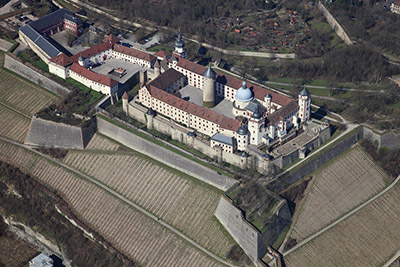 |
Festung Marienberg
Würzburg, Germany
|
|
 |
Constructed: 1635 - ?
Used by: Bavaria, Germany
Conflict in which it participated:
Austro-Prussian War
|
Thanks to its undeniably awesome strategic location at a bend in the Main River, the spot where Festung Marienberg sits today has been fortified in one way or another as far back as the Bronze Age (3200-600BC). The oldest structure still at the fort is a small church, which dates to 704AD.
Addition and modernization occurred constantly, and by the 13th century a castle with a deep well had been built at the location of our present interest. Festung Marienberg, in its various forms, was used as the residence of the Würzburg Prince-Bishops (why be just a prince or a bishop when you can be both?) from 1253 until the 18th century.
Festung Marienberg's genesis as a starfort, however, came thanks to the Swedes during the Thirty Years' War (1618-1648).
|
 |
|
|
For 'twas during this war that Swedish troops came to Würzburg, in 1631. At the time, Würzburg was busy enjoying one of the largest mass trials ever held in peacetime, a public service held in the interest of burning as many women as humanly possible: Witch trials! Würzburg's Prince-Bishops were so delighted with the burning of 600 to 900 "witches" that they failed to notice that the "father of modern warfare," Swedish King Gustavas Adolphus (1594-1632), was creeping up behind them.
|
 Starfortage around an earlier fortification: Clear evidence of someone's belated starfort epiphany! Might I add, in a completely nonpartisan manner, that this picture is awesome. Starfortage around an earlier fortification: Clear evidence of someone's belated starfort epiphany! Might I add, in a completely nonpartisan manner, that this picture is awesome. |
 |
Sweden easily captured Würzburg, despite the presence of Festung Marienberg, and hung around until finally being expelled in 1634. Once returned to power, the Prince-Bishops agreed that the Festung certainly hadn't fulfilled its primary function in that situation, and determined to drag Marienberg kicking and screaming into the 17th century, with a Trace Italienne facelift.
This process likely began in 1635, and builders were constantly at work over the next several years, adding and improving. The Festung's walls eventually reached over twelve kilometers in length. Whatever a "kilometer" is.
|
|
Würzburg remained a relatively peaceful stadt for the next couple of centuries (unless you were a witch). Those oft-mentioned Prince-Bishops ruled over the region from Festung Marienberg, at least until a grand palace called the Würzburg Residence was completed in 1744. Our Festung was thereafter primarily used as a prison (again for the witches, whom, if they really were witches, surely could have witched their way out of a jail cell).
|
Prussia instigated what would become the Austro-Prussian War (1866) so that Otto Von Bismarck (1815-1898) could influence, in Prussia's favor, the formation of an actual Germany from the huge, steaming pile of pseudo-German bitty statelets that had existed in Central Europe for centuries.
The wicked Prussian army came to Würzburg in July of 1866 and directed artillery fire upon the Festung Marienberg. This caused at least some portion of the fortress to catch fire, but the brave Bavarian artillerists defending Marienberg returned fire with deft precision. This bombardment took place on July 26, 1866: The same day that an armistice was signed, ending this war! The Prussians won the war, but never conquered Festung Marienberg.
|
 |
Nice to have pretty flowers in your starfort. The Prince Gardens have existed in Festung Marienberg as far back as 1523: It's been a floweredfort longer than it's been a starfort! |
|
Festung Marienberg for German- and English-speaking tourists! |
 |
The Nazis, discerning fortlovers that they were, occupied Festung Marienberg during the Second World War (1939-1945), making it their "fortress of the community thought." Though this certainly sounds sinister, it was merely a Hilfwerkslager, a training center for "unemployed comrades" (which also sounds sinister, but that's only because of the word comrades). The relatively harmless nature of this facility didn't prevent the US Army Air Corps from bombing the snot out of it in 1945, causing the significant damage that one might expect in such a situation.
But Würzburg loved its fortress, and had rebuilt it by 1950. Today, Festung Marienberg houses two museums: The Mainfrankisches Museum, one of the largest art collections in Bavaria; and the Fürstenbaumuseum, which presents the history of Würzburg. This museum, also called The Princes' Museum, contains two models: One of the city of Würzburg around 1525; the second, a devastated Würzburg after the attentions of the US Army Air Corps in 1945. Thanks, America!! |
|
|
|
|
|
|
 |




